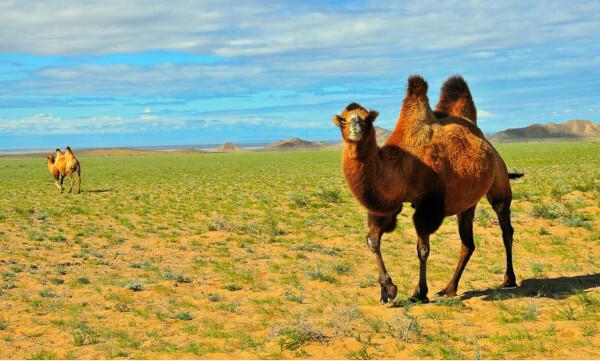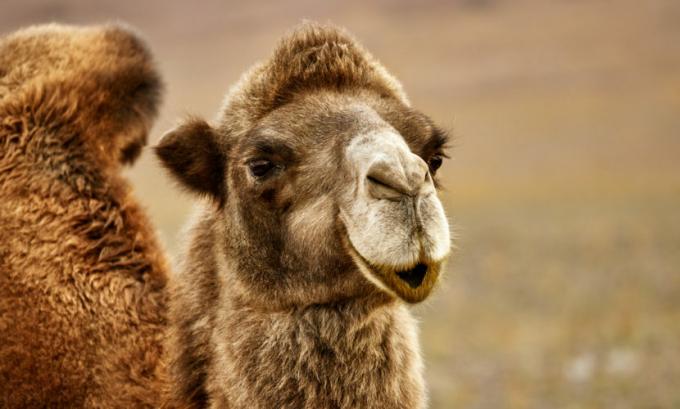You camels they are animalsmammals which have as a striking feature the presence of two humps on your back. According to the IUCN, the camel is currently restricted to four subpopulations in China and Mongolia, however, domestic camels, classified as a species unlike wild camels, they can also be seen in other regions, such as Iran, Afghanistan, Pakistan and Kazakhstan.
Read too: Domestic and wild animals - examples and differences
camel taxonomy
Camels are mammalian animals and therefore belong to the kingdom animalia, phylum Chordata and class Mammalia. The camel belongs to the order Cetarthiodactyla, the family camelid and to gender Camelus. Wild camels belong to the species Camelus ferus, while domestics belong to the species Camelus Bactrianus.
Camel characteristics
Camels are mammals that have two humps, formed by reserves of fat, and a body full of hair. Typically the coat is dark brownThe or gray. The coat is heavier and thicker in the hump, head, neck, forelegs and tail. The hairs fall out when the temperature rises.

camels are large animals, having more than two meters in height. The length of the head and body is 2.25 m to 3.45 m, the tail having a length of 0.35 m to 0.55 m. Camels weigh, as adults, between 300 kg and 690 kg. Generally speaking, males are larger than females. Camel calves are born weighing around 37 kg.
These animals live in the region of desert rocky and barren, being often exposed to strong winds, which throw sand and dust in their eyes. To get around this situation, camels have long eyelashes, which protect their eyes. Your nostrils have the ability to close to protect you from the sand.
Because they live in desert regions, camels suffer from a shortage of Water. THE wild species is adapted to drinking brackish desert water, which has a higher salt content than the water present in the sea. In addition, they are able to sustain themselves with the water they take from their food.
You wild camels usually live in herds from six to 20 members, and can also be seen alone or in larger groups. Camel groups consist of an alpha male, adult females and their young. The male offspring, when they reach sexual maturity, are pushed away by the alpha male and join a group of other males.
Camel feeding

Camels are animals that present diet basically composed of vegetables, being considered herbivores by several authors. Some authors highlight, however, the ability of, in environmental stress, they feed on other animals and even on clothes and shoes, and it is better to classify them, therefore, as omnivorous animals.
It is important to point out that, in times of nutrient scarcity, camels have their humps as energy sources. They are composed of adipose tissue, which works as an energy reserve. Slanted, small humps indicate that the camels are lacking in nutrients. In well-nourished animals, these humps are firm and erect.
camels are mammals ruminants, presenting, therefore, a stomach divided into four chambers. During the digestion process, food passes through the mouth twice.
Read more: Animal feeding - types and classification
camel reproduction
Camels are animals that have a polygamous mating system, that is, the male has more than one female as a mate at the same time. The dominant male mates with any female in the group and is also responsible for protecting females from wandering camels. To frighten these males, camels adopt behaviors such as biting, spitting, snorting and fighting.
Camel gestation lasts between 360 and 440 dayss and is responsible for generating, generally, a offspring. Puppies that are born in the wild are normally weaned in the first two years, however, in captivity, weaning can occur earlier.
THE full maturity of the camel is reached, on average, at the age of five, this being the period in which he begins his independence. Before full sexual maturity, puppies accompany their mother. Females protect them, becoming aggressive when they feel threatened. In nature, camels they can live up to 50 years.
Difference between camels and dromedaries

Camels and dromedaries are different animals, however, very confused by the population. Dromedaries, as well as camels, belong to the family camelid and to gender Camelus, being Camelus dromedariusthe species to which the dromedary belongs. Dromedaries are found in the Middle East, northern India and Africa.
The main difference between camels and dromedaries is in their hump, which is unique in dromedaries. As in camels, the hump is composed of fat, which acts as an energy reserve, an important adaptation for these animals, which live in environments subject to food scarcity.

